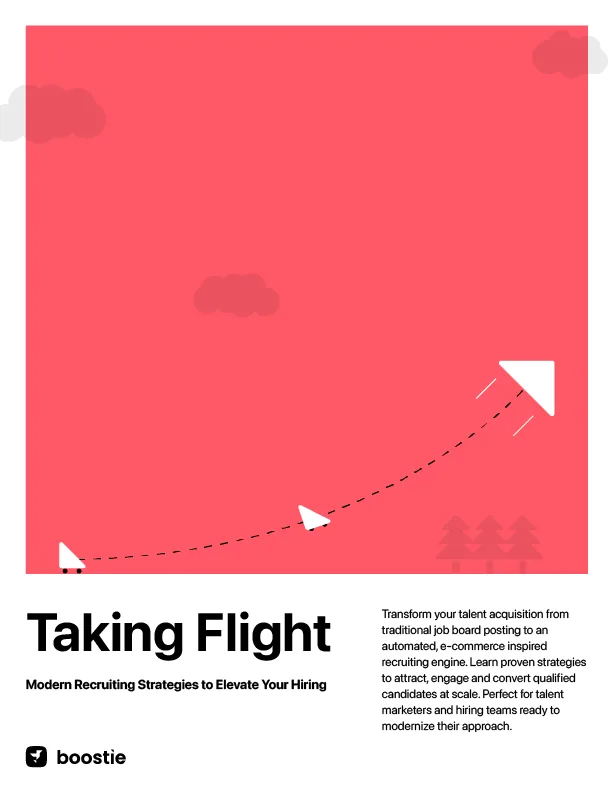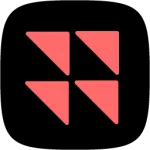Playbook: Modern Recruiting Strategies
Taking Flight
Discover how modern recruiting strategies inspired by e-commerce can help you find and attract better talent, faster.
E-commerce? For hiring?
Remember the last time you shopped online? The personalized recommendations, the smooth checkout, the real-time updates – it just worked. What if your talent marketing process worked the same way?
That question is what led to us building Boostie.
The truth is, the marketing process for hiring teams is stuck in 2010 while e-commerce has stayed on the front-edge of targeting and conversion.
We post jobs and pray the right people find them. We make candidates jump through repetitive hoops. We lose great talent to clunky processes. The process isn't optimized for a modern candidate and customer experience.
But what if hiring worked like modern e-commerce?
Imagine targeting the right candidates before they even start looking. Picture a world where applying feels as natural as checking out on your favorite shopping site. Think about nurturing talent pools the way e-commerce builds customer relationships.
In this guide, we'll show you exactly how to make a shift in your talent marketing strategies. You'll learn practical tips from e-commerce that transform how you attract, engage, and convert top talent.
The future of hiring isn't about posting and praying. It's about precision, automation, and exceptional experiences. Let's take flight together.
Travis Arnold
Co-Founder & CEO, Boostie
Chapter 1:
Pre-Flight - Building Your Modern Talent Engine
Assessing Your Current Stack
Before any major transformation, successful e-commerce companies perform a thorough audit of their existing tools and processes. The same approach works for modernizing your talent acquisition. In this section, we'll help you identify what's working, what isn't, and where the biggest opportunities lie. Think of this as your pre-flight checklist - you wouldn't take off without ensuring every system is ready for the journey ahead.
Common Pain Points vs E-commerce Solutions
| Traditional Recruiting | E-commerce Parallel | Modern Solution |
|---|---|---|
| Static job posts | Dynamic product pages | AI-powered job promotions |
| One-size-fits-all applications | Personalized shopping experiences | Smart application flows |
| Manual candidate screening | Automated customer segmentation | Intelligent screening tools |
| Passive talent pool management | Customer lifecycle marketing | Automated nurture campaigns |
Building Your Foundation
Just as e-commerce success is built on a solid technical and experiential foundation, modern recruiting requires the right infrastructure. This section walks you through the essential components you'll need to transform your talent acquisition approach. We'll cover everything from your digital storefront (your careers site) to your conversion tools (your application process) and marketing machinery.
1. Your Talent Marketing Hub
Think of your careers site like an e-commerce storefront. In that context it needs to:
- Load fast and look great on mobile
Slow sites lose candidates just like they lose customers. Make sure your careers site loads quickly on all devices. - Show clear value propositions
Tell candidates exactly what makes your company unique. Lead with benefits, culture, and growth opportunities.
- Make the next step obvious
Every page should have a clear call-to-action. Don't make candidates hunt for the apply button.
- Capture interested browsers
Not everyone's ready to apply today. Offer easy ways to stay connected through job alerts or talent networks.
2. Your Application Experience
Map your current application flow against popular e-commerce checkouts. Where could you:
- Reduce form fields
Ask only what you absolutely need to make a first-pass evaluation. Save detailed questions for later in the process.
- Add progress indicators
Show candidates exactly where they are in the process. Knowledge reduces abandonment.
- Save partial progress
Let candidates finish their application later. Life happens – don't lose good talent to interruptions.
- Enable one-click apply for return visitors
Make it easy for candidates to apply to multiple roles. Store their information securely for return interactions.
3. Your Marketing Channels
Just as e-commerce uses multiple channels to reach customers, your talent marketing needs:
- Paid search for high-intent job seekers
Capture active job seekers when they're ready to apply. Target specific job titles and skills.
- Display ads for passive talent
Reach qualified candidates before they start looking. Focus on relevant audience segments.
- Social promotion for brand building
Share your culture and opportunities where candidates spend time. Build relationships before you need to hire.
- Retargeting for interested candidates
Stay visible to candidates who've shown interest. Remind them why they looked in the first place.
Pre-Flight Checklist
Every successful launch needs a systematic approach. This checklist serves as your pre-flight inspection, ensuring you've covered all crucial aspects before modernizing your talent acquisition strategy. Use it to track your progress and identify any areas that need attention before takeoff.
- Audit current tools and processes
Catalog every tool and step in your current hiring workflow. Identify redundancies and gaps that slow down your process. - Map candidate journey touch points
Document every interaction candidates have with your company, from first click to final offer. This reveals where you're losing good candidates. - Identify major friction points
Look for steps where candidates drop off or get stuck. These are your priority fixes for improving conversion. - Set baseline metrics
Measure your current performance across key metrics like time-to-hire and cost-per-hire. You can't improve what you don't measure. - Define success criteria
Set clear, measurable goals for your recruiting transformation. Align these with your broader hiring objectives.
Measuring Readiness
You can't improve what you don't measure. Just as e-commerce companies track conversion rates and customer behavior, modern recruiting requires clear metrics to gauge success. Before launching your transformation, you need to establish baseline measurements and set clear targets. Here are the key metrics you should track:
- Application completion rate
The percentage of started applications that get submitted. This reveals how well your apply process works. - Time-to-apply
How long it takes to complete your application. Shorter is usually better, but ensure you're getting quality information. - Channel performance
Which sources bring your best candidates? Track both quantity and quality metrics for each channel. - Cost per qualified applicant
What you're spending to get good candidates. Break this down by channel and role type. - Candidate satisfaction scores
What applicants think about your process. Collect feedback at key touchpoints to identify improvements.
Common Preparation Pitfalls
Even the most well-planned transformations can stumble on common obstacles. By understanding these typical challenges upfront, you can avoid the mistakes others have made and ensure a smoother transition to modern recruiting. Here are the most frequent pitfalls we've observed and how to avoid them:
- Trying to Fix Everything at Once Solution
Focus on one improvement at a time. Start with changes that will have the biggest impact on your hiring goals. - Focusing on Technology Over Experience Solution
Don't let shiny tools distract from the candidate experience. Choose technology that makes applying easier, not harder.
- Ignoring Mobile Users Solution
Most job seekers browse on mobile first. Test your entire process on phones and tablets.
- Skipping the Data Foundation Solution
Set up proper tracking before making changes. Good data helps you make better decisions.
Pre-Flight Workshop Questions
Success requires honest self-assessment. These questions are designed to help you and your team evaluate your current state and identify priority areas for improvement. Take time to discuss these with your team - the answers will guide your transformation journey and help you focus on the most impactful changes first.
- What's your current application completion rate?
- How many steps does your application process have?
- What percentage of your traffic comes from mobile?
- How do you currently capture passive candidate interest?
- What's your average time-to-hire?

Download a copy
Take a copy for the road, to share with a friend or to just stare into wonderingly.
Chapter 2:
Takeoff - Launching Your Modern Talent Strategy
Setting the Stage for Launch
Just as successful e-commerce launches require careful planning and coordination, transforming your talent acquisition approach needs a strategic rollout. This chapter will guide you through launching your modern recruiting engine, from initial campaign setup to creating frictionless experiences that convert passive browsers into active candidates.
Multi-Channel Campaign Launch
Think of your job promotions like product launches - they need presence across multiple channels to reach the right audience at the right time.
1. Search Channel Strategy
- Identifying high-intent keywords
Focus on terms that show clear job-seeking intent. Think beyond basic job titles to include skills, location, and industry preferences. - Creating compelling ad copy
Write ads that speak to candidate motivations. Test different value propositions to see what drives the best response. - Optimizing landing pages for conversion
Every click should land on a page that matches search intent. Include clear next steps and relevant job details upfront. - Setting up tracking and attribution
Know which channels bring your best candidates. Track the full journey from first click to application.
2. Social & Display Targeting
- Building custom audiences
Create targeting based on job titles, skills, and interests. Use your best employees as models for look-alike audiences. - Creating engaging creative
Design ads that stop the scroll. Test different formats and messages to find what resonates. - Setting up retargeting flows
Keep your jobs visible to interested candidates. Show different messages based on their previous interactions. - Measuring engagement metrics
Look beyond basic click rates. Track meaningful interactions that lead to quality applications.
3. Passive Talent Outreach
- Developing nurture sequences
Build relationships before you need to hire. Share valuable content that helps candidates advance their careers. - Creating valuable content
Share insights that help candidates grow professionally. Mix company culture with industry knowledge. - Building segmented talent pools
Organize candidates by skills, interests, and engagement level. This enables personalized communication at scale. - Automating personalized outreach
Use automation to stay in touch without losing authenticity. Trigger relevant messages based on candidate behavior.
Creating Frictionless Applications
The moment of truth in e-commerce is the checkout process. In recruiting, it's the application experience.
Essential Elements:
- Smart form pre-fill
Don't ask for information you already have. Remember returning candidates and their details. - Progress saving
Let candidates pick up where they left off. Life happens – don't lose good talent to interruptions. - Mobile optimization
Ensure a smooth experience on every device. Test your entire application flow on phones and tablets. - Clear next steps
Tell candidates exactly what happens after they apply. Set clear expectations about timeline and process.
First Touch Automation
Like e-commerce welcome sequences, your initial candidate interactions should be immediate and relevant.
Key Components:
- Instant acknowledgments
Confirm receipt immediately. Thank candidates for their time and interest. - Expected timeline communication
Set clear expectations about next steps. Tell candidates when they'll hear from you. - Next step previews
Outline what the hiring process looks like. Help candidates prepare for what's ahead. - Personalized content delivery
Share relevant information based on the role. Include team insights and culture highlights.
Launch Metrics to Track
Monitor these metrics during your first 30 days:
- Channel performance comparisons
- Application completion rates
- Source quality metrics
- Time-to-first-response
- Candidate satisfaction scores
Launch Checklist
- All tracking codes implemented
Verify your analytics can track the full candidate journey. Ensure proper attribution across channels. - Campaign budgets allocated
Set clear budgets for each channel. Start small, measure results, then scale what works. - Automation flows tested
Test every automated message and trigger. Ensure a smooth experience for all candidates. - Mobile experience verified
Check every touchpoint on multiple devices. Fix any mobile usability issues. - Response templates ready
Prepare templates for common situations. Maintain consistency while staying personal. - Team training completed
Ensure everyone knows their role. Create clear processes for handling applications.
Common Launch Challenges
- Budget Distribution Solution
Start small, test, then scale what works - Creative Bottlenecks Solution
Use AI-powered content generation - Team Adoption Solution
Clear training and easy-to-follow processes - Technical Issues Solution
Thorough testing across devices
Launch Workshop Questions
- Which channels show the highest quality candidates?
- What's your cost per application by source?
- Which automation flows need optimization?
- How are candidates rating their experience?
- What feedback are you getting from hiring managers?

Download a copy
Take a copy for the road, to share with a friend or to just stare into wonderingly.
Chapter 3:
Cruising Altitude - Optimizing Your Talent Engine
Now that you're airborne with your modern talent acquisition strategy, it's time to optimize performance. Like an e-commerce engine, your recruiting machine needs constant fine-tuning to maximize results.
Fine-Tuning Your Channels
Just as e-commerce marketers optimize their sales channels, you'll need to regularly adjust your talent marketing mix. Focus on what's working and fix what isn't.
Search Optimization
The foundation of any good talent marketing strategy: continuously refine your approach based on real performance data.
- Keyword performance review
Analyze which search terms bring quality candidates. Cut underperforming keywords and double down on winners. - Quality score improvements
Better quality scores mean lower cost per click. Match landing pages and ad copy closely to search intent. - Budget reallocation
Shift spend toward your best-performing campaigns. Test new channels with small budgets before scaling. - Landing page testing
Test different page layouts and content. Small improvements in conversion add up quickly.
Social Campaign Enhancement
- Creative refresh
Update your ad creative regularly. Test new formats and messages to prevent ad fatigue. - Audience refinement
Narrow targeting based on performance data. Build new audiences from your best-converting segments. - Engagement optimization
Focus on actions that lead to applications. Don't chase vanity metrics like basic post likes. - Content strategy adjustment
Create content that drives meaningful interaction. Mix culture, careers, and industry insights.
Improving the Application Flow
Your application process is your checkout flow. Every unnecessary step costs you qualified candidates.
- Drop-off analysis
Find where candidates abandon your process. Fix the biggest friction points first. - Form field optimization
Review every field in your application. If you don't need it now, don't ask for it. - Mobile experience enhancement
Make applying as easy on phones as computers. Test on multiple devices regularly. - Save and return features
Let candidates complete applications in multiple sessions. Don't lose good talent to bad timing.
Automation Refinement
Smart automation helps you scale personal touches. Regular refinement ensures your automated communications stay relevant and effective.
- Message timing
Test different send times for automated messages. Match your communication to candidate preferences. - Response rate analysis
Track which messages get the best engagement. Replicate successful communication patterns. - Workflow efficiency
Look for manual tasks you can automate. Save your team's time for human interaction. - Personalization improvements
Enhance how you tailor messages to candidates. Use data to make communications more relevant.
Analytics Deep Dive
Data drives improvement. These metrics help you understand what's working and what needs attention.
- Source quality metrics
Track which channels bring your best hires. Consider both quantity and quality of applications. - Cost per hire analysis
Calculate true costs across all channels. Include both direct and indirect recruiting costs. - Time to fill tracking
Measure how long it takes to fill different roles. Identify bottlenecks in your process. - Quality of hire metrics
Track early performance indicators of new hires. Connect recruiting sources to employee success.
Optimization Checklist
Your regular maintenance schedule. These checks help keep your talent engine running smoothly.
- Weekly performance review
Check key metrics weekly. Spot trends before they become problems. - A/B test analysis
Review test results regularly. Apply winning variations quickly. - Budget optimization
Adjust spending based on performance. Scale what works, cut what doesn't. - Candidate feedback review
Listen to what applicants tell you. Use feedback to guide improvements. - Process efficiency audit
Look for ways to streamline your workflow. Remove unnecessary steps and friction. - System integration check
Ensure all your tools work together smoothly. Fix any data flow issues promptly.

Download a copy
Take a copy for the road, to share with a friend or to just stare into wonderingly.
Outro
The Journey Forward
The shift from traditional recruiting to modern talent marketing isn't just about new tools – it's about a new mindset. Throughout this guide, we've shown how e-commerce principles can transform your approach to finding and attracting talent.
Key Takeaways
- Think like a marketer
Your jobs are products, and candidates are customers. Build experiences that match their expectations. - Automate with purpose
Let technology handle repetitive tasks so your team can focus on meaningful candidate interactions. - Test and optimize
Use data to guide improvements. Small optimizations add up to significant results. - Stay candidate-centric
Every improvement should make the candidate experience better, faster, or simpler.
Your Next Steps
- Start small
Pick one area from this guide to implement first. Early wins build momentum for bigger changes. - Measure impact
Track your baseline metrics now. Document improvements as you implement changes. - Share success
Build internal buy-in by showing how these changes improve results. - Keep learning
The best practices of today will evolve. Stay curious and keep experimenting.
Ready for Takeoff?
The future of recruiting is already here. Forward-thinking companies are treating talent acquisition like e-commerce, and they're seeing remarkable results. Whether you're just starting this journey or looking to optimize your current approach, the strategies in this guide will help you build a modern, effective talent acquisition engine.
The path to better hiring starts here. Ready to take flight?



